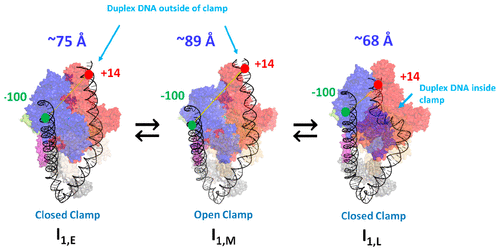当前位置:
X-MOL 学术
›
Biochemistry
›
论文详情
Our official English website, www.x-mol.net, welcomes your
feedback! (Note: you will need to create a separate account there.)
Fluorescence-Detected Conformational Changes in Duplex DNA in Open Complex Formation by Escherichia coli RNA Polymerase: Upstream Wrapping and Downstream Bending Precede Clamp Opening and Insertion of the Downstream Duplex.
Biochemistry ( IF 2.9 ) Pub Date : 2020-04-07 , DOI: 10.1021/acs.biochem.0c00098 Raashi Sreenivasan , Irina A. Shkel , Munish Chhabra , Amanda Drennan , Sara Heitkamp , Hao-Che Wang , Malavika A. Sridevi , Dylan Plaskon , Christina McNerney , Katelyn Callies , Clare K. Cimperman , M. Thomas Record
Biochemistry ( IF 2.9 ) Pub Date : 2020-04-07 , DOI: 10.1021/acs.biochem.0c00098 Raashi Sreenivasan , Irina A. Shkel , Munish Chhabra , Amanda Drennan , Sara Heitkamp , Hao-Che Wang , Malavika A. Sridevi , Dylan Plaskon , Christina McNerney , Katelyn Callies , Clare K. Cimperman , M. Thomas Record

|
FRET (fluorescence resonance energy transfer) between far-upstream (-100) and downstream (+14) cyanine dyes (Cy3, Cy5) showed extensive bending and wrapping of λPR promoter DNA on Escherichia coli RNA polymerase (RNAP) in closed and open complexes (CC and OC, respectively). Here we determine the kinetics and mechanism of DNA bending and wrapping by FRET and of formation of RNAP contacts with -100 and +14 DNA by single-dye protein-induced fluorescence enhancement (PIFE). FRET and PIFE kinetics exhibit two phases: rapidly reversible steps forming a CC ensemble ({CC}) of four intermediates [initial (RPC), early (I1E), mid (I1M), and late (I1L)], followed by conversion of {CC} to OC via I1L. FRET and PIFE are first observed for I1E, not RPc. FRET and PIFE together reveal large-scale bending and wrapping of upstream and downstream DNA as RPC advances to I1E, decreasing the Cy3-Cy5 distance to ∼75 Å and making RNAP-DNA contacts at -100 and +14. We propose that far-upstream DNA wraps on the upper β'-clamp while downstream DNA contacts the top of the β-pincer in I1E. Converting I1E to I1M (∼1 s time scale) reduces FRET efficiency with little change in -100 or +14 PIFE, interpreted as clamp opening that moves far-upstream DNA (on β') away from downstream DNA (on β) to increase the Cy3-Cy5 distance by ∼14 Å. FRET increases greatly in converting I1M to I1L, indicating bending of downstream duplex DNA into the clamp and clamp closing to reduce the Cy3-Cy5 distance by ∼21 Å. In the subsequent rate-determining DNA-opening step, in which the clamp may also open, I1L is converted to the initial unstable OC (I2). Implications for facilitation of CC-to-OC isomerization by upstream DNA and upstream binding, DNA-bending transcription activators are discussed.
中文翻译:

大肠杆菌RNA聚合酶在开放复合物形成中双链DNA的荧光检测构象变化:上游包裹和下游弯曲先于下游双链钳的打开和插入。
上游(-100)和下游(+14)花青染料(Cy3,Cy5)之间的FRET(荧光共振能量转移)显示,λPR启动子DNA广泛弯曲并包裹在封闭和开放复合物中的大肠杆菌RNA聚合酶(RNAP)上(分别为CC和OC)。在这里,我们确定了通过FRET进行DNA弯曲和包裹以及通过单染料蛋白诱导的荧光增强(PIFE)与-100和+14 DNA形成RNAP接触的动力学和机理。FRET和PIFE动力学表现出两个阶段:快速可逆的步骤,形成四个中间体[初始(RPC),早期(I1E),中期(I1M)和晚期(I1L)]的CC合奏({CC}),然后转化为通过I1L将{CC}传送到OC。首先观察到FRET和PIFE的I1E,而不是RPc。当RPC前进到I1E时,FRET和PIFE一起揭示了上游和下游DNA的大规模弯曲和包裹,将Cy3-Cy5距离减小到〜75Å,并使RNA-DNA在-100和+14处接触。我们建议,上游DNA包裹在上部的β'钳夹上,而下游DNA则与I1E中的β夹子的顶部接触。将I1E转换为I1M(约1 s的时间尺度)会降低FRET效率,而-100或+14 PIFE几乎没有变化,这被解释为钳位打开,从而将上游DNA(位于β'上)从下游DNA(位于β上)移开以增加Cy3-Cy5距离约为14Å。在将I1M转换为I1L时,FRET大大增加,表明下游双链DNA弯曲到钳位和钳位闭合中,从而使Cy3-Cy5距离减少了约21Å。在随后的速率确定DNA开启步骤中,夹具也可能会开启,I1L转换为初始不稳定OC(I2)。讨论了通过上游DNA和上游结合促进CC-OC异构化的含义,即弯曲DNA的转录激活因子。
更新日期:2020-04-23
中文翻译:

大肠杆菌RNA聚合酶在开放复合物形成中双链DNA的荧光检测构象变化:上游包裹和下游弯曲先于下游双链钳的打开和插入。
上游(-100)和下游(+14)花青染料(Cy3,Cy5)之间的FRET(荧光共振能量转移)显示,λPR启动子DNA广泛弯曲并包裹在封闭和开放复合物中的大肠杆菌RNA聚合酶(RNAP)上(分别为CC和OC)。在这里,我们确定了通过FRET进行DNA弯曲和包裹以及通过单染料蛋白诱导的荧光增强(PIFE)与-100和+14 DNA形成RNAP接触的动力学和机理。FRET和PIFE动力学表现出两个阶段:快速可逆的步骤,形成四个中间体[初始(RPC),早期(I1E),中期(I1M)和晚期(I1L)]的CC合奏({CC}),然后转化为通过I1L将{CC}传送到OC。首先观察到FRET和PIFE的I1E,而不是RPc。当RPC前进到I1E时,FRET和PIFE一起揭示了上游和下游DNA的大规模弯曲和包裹,将Cy3-Cy5距离减小到〜75Å,并使RNA-DNA在-100和+14处接触。我们建议,上游DNA包裹在上部的β'钳夹上,而下游DNA则与I1E中的β夹子的顶部接触。将I1E转换为I1M(约1 s的时间尺度)会降低FRET效率,而-100或+14 PIFE几乎没有变化,这被解释为钳位打开,从而将上游DNA(位于β'上)从下游DNA(位于β上)移开以增加Cy3-Cy5距离约为14Å。在将I1M转换为I1L时,FRET大大增加,表明下游双链DNA弯曲到钳位和钳位闭合中,从而使Cy3-Cy5距离减少了约21Å。在随后的速率确定DNA开启步骤中,夹具也可能会开启,I1L转换为初始不稳定OC(I2)。讨论了通过上游DNA和上游结合促进CC-OC异构化的含义,即弯曲DNA的转录激活因子。











































 京公网安备 11010802027423号
京公网安备 11010802027423号